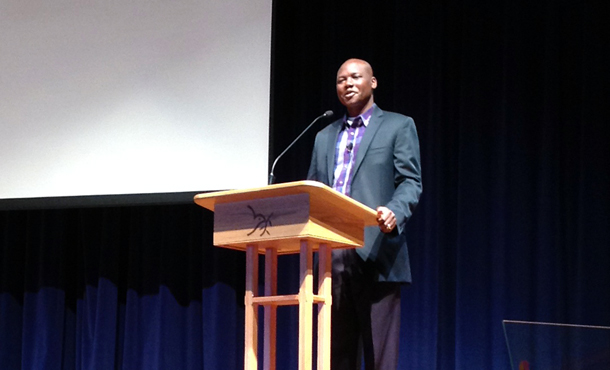To explain the dramatic changes in missions engagement over the last half-century, Nelson Okanya, MDiv ’03, president of Eastern Mennonite Missions, utilizes a stark image: a sturdy bridge, spanning a flat plain of dirt while the river courses hundreds of feet away.
This bridge actually exists in Honduras: it was built in the 1930s by the Army Corps of Engineers as part of the Pan-American Highway, but was abandoned in 1998 when the river changed its course after a hurricane.
“It is still beautiful and it still stands,” said Okanya, during a lecture at Eastern Mennonite University, “but the river is not there. The river has moved.”
Similarly, Okanya said, the historical, traditional model of mission engagement – with churches of the global north “sending” missionaries into the “receiving” global south – must be restructured to accommodate changing flows of worldwide Anabaptist faith.
Okanya’s visit to campus, in which he also spoke at two worship services, is part of the annual Augsburger Lectureship, originally funded by Myron S. and Esther Augsburger to address “topics in the area of Christian evangelism and mission for the stimulation and development of a vision for evangelism and missions for the EMU community.”
The first mission took place in the 1930s, Okanya reminded the audience during his chapel sermon, and those who were called, and those who sent them, were compelled by the powerful story of Jesus Christ. Like the early martyrs of the Anabaptist faith, they suffered for their faith. “You can see their graves,” Okanya said, recalling Elam Stauffer ’64, one of the first missionaries to be sent by EMM. Stauffer suffered for his convictions, losing an infant and then his wife, Elizabeth, after arriving in Tanzania.
Young people seeking purpose are often confronted with the popular narrative of “moving towards something we will get for doing things right,” Okanya said, adding that he too went to college for this reason. Yet there is an alternative narrative: the one followed by missionaries.
Think about “the difference that you can make in life because you are completed not by what you can get but in response to the One who loves you and gave you life,” he urged.
Okanya, who was born and raised in Kenya, pointed as evidence of this compelling narrative and the power of missions to the rapidly growing numbers of Mennonites in Africa. The Democratic Republic of the Congo and Ethiopia have the largest number of Mennonites in the world, behind the United States.
In his youth, Okanya interacted with the Kenya Mennonite Church and the EMM mission community in Nairobi. (When he preaches, he wanders away from the microphone, Okanya joked, because he is still a “Kenyan shepherd boy” at heart.) After graduating from university in Nairobi, Okanya came to the Baltimore area with the YES (Youth Evangelism Service) program and eventually attended seminary at EMU, where he met his wife Jessica Lawrence Okanya ’01.
Okanya has served as president of EMM since 2011, following years of mission work and also six years as lead pastor of Capital Christian Fellowship in Lanham, Maryland.
In his lecture titled “What Needs to Change? A Paradigm Shift in Missions Engagement and Implications for Western Mission Agencies,” Okanya shared some of the challenges affecting mission work today. He and his staff continue to grapple with the question of “what it means to be missional in today’s environment,” considering the issues of sustainable funding mechanisms, human resources, increasing hostility toward Westerners, changing stakeholders and globalization.
“There is a lot the church in North America can offer the world,” he said, “but there is much that the churches in the global South can offer us here. I’ve met with Lancaster Conference bishops asking about receiving missionaries here. What does that mean? What are the benefits? They want to know this and we want to help them.”
The way to engage youth in missions, and in church itself, is sharing and teaching with authenticity, Okanya said, just as the prophets, disciples and Jesus himself did.
“Are we ‘almost Christian’?” he asked, using a term coined by author Kendra Dean Creasy. “Are we not serious enough about our faith and not taking seriously what He said and what He meant? We lack the strength to tell the story, and if we do not have it, then we cannot pass it on. We must be passionate.”
